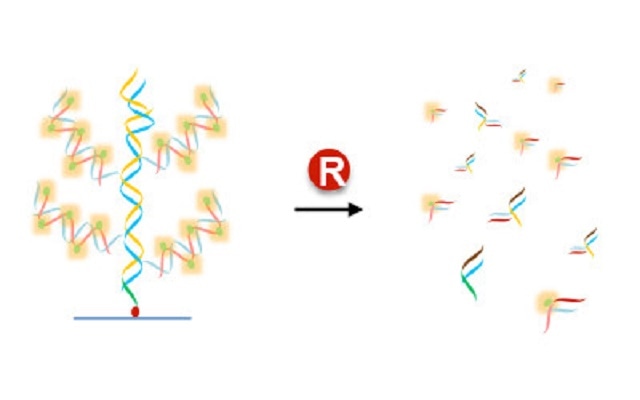May 19 2016
Nanomaterials or DNA-based straight and branched polymers, which can be formed and dissolved using biocompatible techniques, are currently possible because of the work of biomedical engineers from Penn State.
 A nanotree made of DNA can be reversed under standard physiological conditions without burning, according to a new study by a team of Penn State biomedical engineers. Image: Penn State
A nanotree made of DNA can be reversed under standard physiological conditions without burning, according to a new study by a team of Penn State biomedical engineers. Image: Penn State
Synthetic polymers might pave the way to advances in a wide range of biomedical and biological applications like molecular detection, drug delivery, and bioimaging.
Achieving reversibility of synthetic polymers and nanomaterials has been a long-standing dream for many biomedical engineers. Scientists want to see these polymers reverse or disappear when we are finished with them, but that often involves the use of high temperatures and chemical solvents. With that idea in mind, the aim of our study was to create synthetic polymers that would decompose without the use of harsh elements or increased stress. In principle, the polymers could be further tuned to synthesize a diverse array of nanomaterials or bulk materials.
Yong Wang, Associate Professor of Biomedical Engineering, Penn State
In order to arrange the dynamic polymers, the scientists combined DNA initiators, which are straight DNA strands with one binding domain, to two DNA monomers with several domains. The bonded molecules created a straight chain double-stranded DNA arrangement with a separate, functional side group. The scientists then invented a trigger molecule that joined to the side group and started a "reverse without the involvement of any non-physiological factors," according to the latest article in Angewandte Chemie International Edition.
The scientists also demonstrated that branched polymers react to the same method. Branched polymers formed with a single linear polymer and two DNA monomers gave rise to two functional side groups with the capability to switch over when induced with a pair of molecular triggers.
The scientists carried out initial model testing in water, with further testing carried out on synthetic antibodies. Antibody trials proved that depolymerization and growth of linear and branched polymers were also possible within both the extracellular matrix and on the microparticle surface.
Wang and his group are expecting that by combining the polymers with different materials and molecules, their results will be valuable for many wide-ranging applications.
Wang collaborated with Niancao Chen, Research fellow, Boston Children's Hospital, Harvard Medical School and recent Penn State Ph.D and Xuechen Shi, Penn State graduate student in Bioengineering for this project.
The study was funded by Integrated National Science Foundation Support Promoting Interdisciplinary Research and Education and the National Institutes of Health Heart, Lung, and Blood Institute.